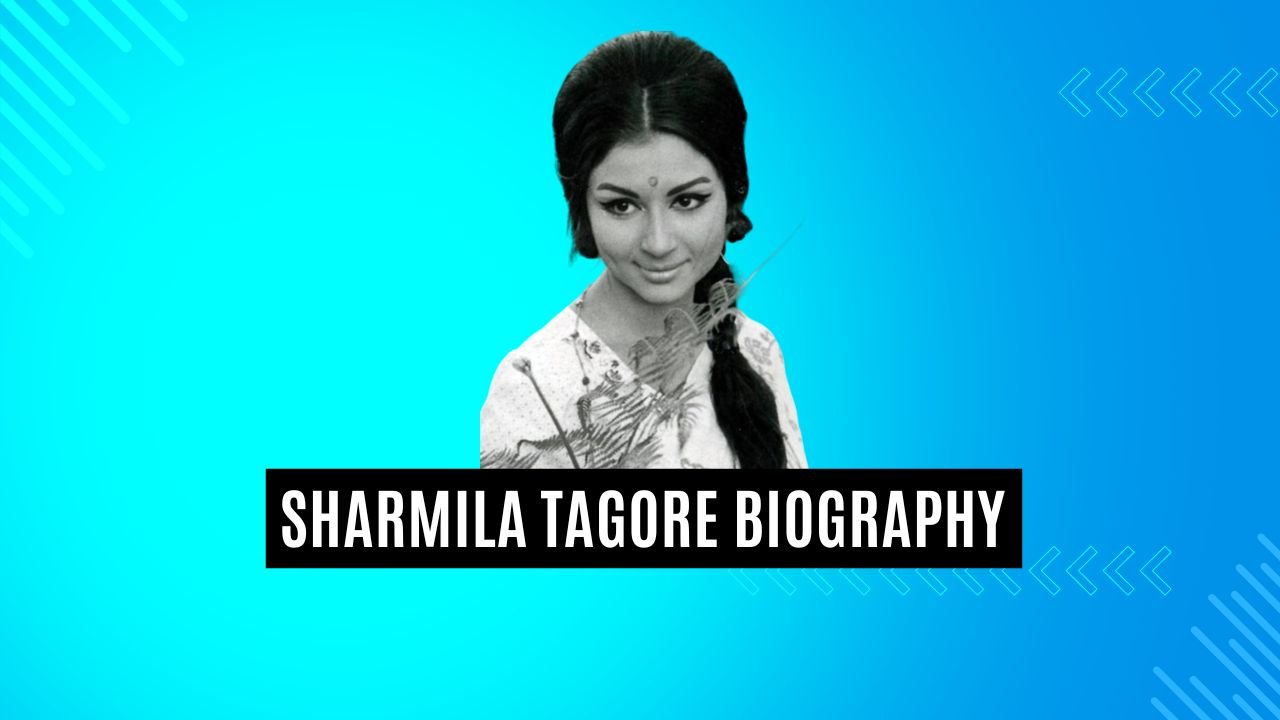Sharmila Tagore Biography: Bollywood, India’s vibrant film industry, has produced numerous iconic actors and actresses over the years, but few have left as indelible a mark as Sharmila Tagore. With her ethereal beauty, unmatched talent, and pioneering spirit, Sharmila Tagore became one of the most celebrated actresses in the history of Indian cinema. This biography delves into her life, from her early days to her illustrious career, and her lasting impact on both Indian and international cinema.
Sharmila Tagore Biography
Early Life and Background
Ayesha Begum Khan, better known as Sharmila Tagore, was born on December 8, 1944, in Hyderabad, British India (now in Telangana, India). She was born into a prominent Bengali family with a rich literary and artistic heritage. Her father, Gitindranath Tagore, was a famous poet, and her great-grandfather was the legendary poet Rabindranath Tagore, who penned India’s national anthem.
Sharmila’s early upbringing was steeped in culture and art, which would later play a significant role in shaping her career. She spent her formative years in Kolkata and was educated at Loreto Convent and St. John’s Diocesan School. Her family’s strong support for education and the arts laid the foundation for her future success.
Entry into Bollywood
Sharmila Tagore’s entry into the world of cinema was not a conventional one. In 1959, she won a beauty contest organized by Filmfare magazine, which opened the doors to the film industry. Her debut film, “Apur Sansar” (The World of Apu), directed by the acclaimed filmmaker Satyajit Ray, released in 1959 when she was just 14 years old. The film was the final installment of Ray’s Apu Trilogy and received widespread critical acclaim.
Her early roles were mostly in Bengali films, and she continued to work with renowned directors like Ray. Sharmila Tagore’s talent and beauty were evident from the start, but it was her transition to Hindi cinema that would catapult her to stardom.
Rise to Stardom
Sharmila Tagore’s breakthrough in Hindi cinema came with the film “Kashmir Ki Kali” (1964), opposite Shammi Kapoor. Her performance as a lively and vivacious Kashmiri girl was well-received, and she garnered attention for her chemistry with Kapoor. This film marked the beginning of her successful career in Bollywood.
Throughout the 1960s and 1970s, Sharmila Tagore starred in numerous successful Hindi films, becoming one of the industry’s leading actresses. Her versatile acting skills were showcased in a wide range of roles, from the romantic heroine in “Aradhana” (1969) opposite Rajesh Khanna to the emotionally charged “Amar Prem” (1972) with Rajesh Khanna, in which she portrayed a courtesan.
Her on-screen persona was a perfect blend of grace, beauty, and talent. Her collaboration with leading actors of that era, including Rajesh Khanna, Dharmendra, and Rajendra Kumar, resulted in several iconic films that remain etched in the memories of Hindi cinema enthusiasts.
Personal Life
While Sharmila Tagore was making waves in the film industry, her personal life also attracted attention. In 1969, she married Mansoor Ali Khan Pataudi, the former captain of the Indian cricket team, and the couple had three children: Saif Ali Khan, Saba Ali Khan, and Soha Ali Khan. Their union symbolized the amalgamation of two high-profile families, cricket royalty and Bollywood stardom.
Despite her marriage, Sharmila continued to act in films, breaking societal norms and establishing herself as a trailblazer. Her ability to balance her personal and professional life was a testament to her determination and strength of character.
International Recognition
Sharmila Tagore’s talent transcended borders, and she gained international recognition for her contributions to cinema. In 1975, she starred in the British film “The Bengali Night” alongside Hugh Grant and Soumitra Chatterjee. Her performance in the film earned her critical acclaim and showcased her versatility as an actress.
Additionally, Sharmila was a jury member at the Cannes Film Festival in 2009, where she contributed to the selection of exceptional films from around the world. Her participation in such prestigious events further solidified her status as a global icon.
Contributions to Indian Cinema
Sharmila Tagore’s influence extended beyond her acting prowess. She was instrumental in shaping Indian cinema in various ways:
a. Women’s Empowerment: Sharmila’s choice of roles often challenged societal norms and stereotypes. She portrayed strong and independent women, inspiring a generation of Indian women to pursue their dreams and break free from traditional gender roles.
b. Cultural Representation: Through her films, she showcased the rich cultural diversity of India, bringing various regional cultures and languages to a wider audience.
c. Acting Excellence: Her dedication to her craft set a high standard for acting in Indian cinema. Her performances in classics like “Devar” (1966), “Maalik” (1972), and “Besharam” (1978) demonstrated her range and depth as an actress.
Awards and Honors
Sharmila Tagore’s illustrious career earned her numerous awards and honors. Some of the most notable accolades include:
a. National Film Awards: She won the National Film Award for Best Actress for her performances in “Mausam” (1975) and “Abar Aranye” (2003).
b. Filmfare Awards: She received several Filmfare Awards, including the Best Actress Award for “Aradhana” (1969) and “Mausam” (1975).
c. Padma Bhushan: In 2013, she was honored with the Padma Bhushan, India’s third-highest civilian award, in recognition of her contributions to Indian cinema.
d. Lifetime Achievement Awards: Sharmila Tagore received lifetime achievement awards from various film festivals and organizations, acknowledging her enduring impact on the film industry.
Later Career and Legacy
As Sharmila Tagore entered the later stages of her career, she continued to act in films selectively, focusing on roles that challenged conventions and reflected the evolving Indian society. Her role as a progressive mother in the film “Life Goes On” (2009) exemplified her commitment to portraying contemporary women who grapple with complex issues.
Sharmila’s legacy extends beyond her own performances. She played a pivotal role in paving the way for future generations of actresses who aspired to balance their careers and personal lives. Her enduring charm and graceful aging also set an example of dignity and poise for women in the public eye.
Conclusion
Sharmila Tagore’s journey from a young girl with a famous surname to an iconic Bollywood actress is a testament to her talent, grace, and determination. Her impact on Indian cinema, both as an actress and a trailblazer, is immeasurable. She not only entertained audiences with her performances but also broke barriers and challenged societal norms, leaving a lasting legacy for generations to come. Sharmila Tagore’s life and career serve as an inspiration to aspiring actors and a reminder of the transformative power of cinema in shaping culture and society.



